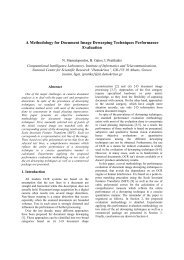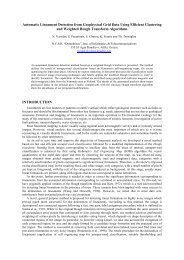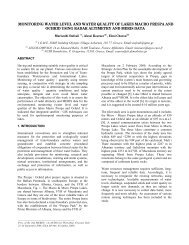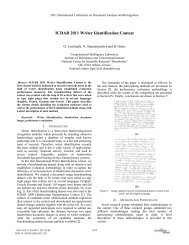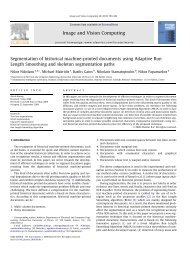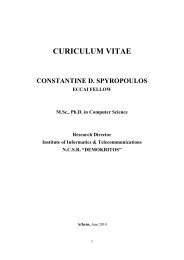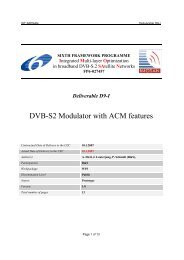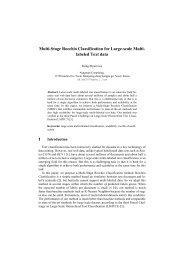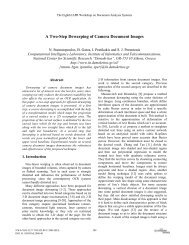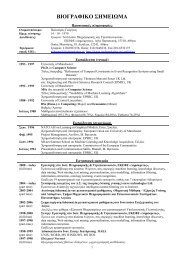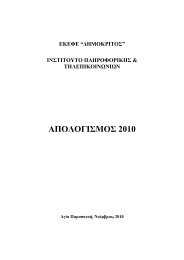TMS320C6713B Floating-Point Digital Signal Processor (Rev. A)
TMS320C6713B Floating-Point Digital Signal Processor (Rev. A)
TMS320C6713B Floating-Point Digital Signal Processor (Rev. A)
Create successful ePaper yourself
Turn your PDF publications into a flip-book with our unique Google optimized e-Paper software.
HOST-PORT INTERFACE TIMING<br />
SPRS294 − OCTOBER 2005<br />
timing requirements for host-port interface cycles †‡ (see Figure 55, Figure 56, Figure 57, and<br />
Figure 58)<br />
NO.<br />
PYP-200,-225<br />
GDP/ZDP -225, -300<br />
PYPA -167, -200 UNIT<br />
GDPA/ZDPA −200<br />
MIN MAX<br />
1 tsu(SELV-HSTBL) Setup time, select signals§ valid before HSTROBE low 5 ns<br />
2 th(HSTBL-SELV) Hold time, select signals§ valid after HSTROBE low 4 ns<br />
3 tw(HSTBL)<br />
Pulse duration, HSTROBE low (host read access)<br />
Pulse duration, HSTROBE low (host write access)<br />
4 tw(HSTBH) Pulse duration, HSTROBE high between consecutive accesses 4P ns<br />
10 tsu(SELV-HASL) Setup time, select signals§ valid before HAS low 5 ns<br />
11 th(HASL-SELV) Hold time, select signals§ valid after HAS low 3 ns<br />
12 tsu(HDV-HSTBH) Setup time, host data valid before HSTROBE high 5 ns<br />
13 th(HSTBH-HDV) Hold time, host data valid after HSTROBE high 3 ns<br />
14 th(HRDYL-HSTBL)<br />
Hold time, HSTROBE low after HRDY low. HSTROBE should not be inactivated<br />
until HRDY is active (low); otherwise, HPI writes will not complete properly.<br />
4P<br />
4P<br />
ns<br />
2 ns<br />
18 tsu(HASL-HSTBL) Setup time, HAS low before HSTROBE low 2 ns<br />
19 th(HSTBL-HASL) Hold time, HAS low after HSTROBE low 2 ns<br />
† HSTROBE refers to the following logical operation on HCS, HDS1, and HDS2: [NOT(HDS1 XOR HDS2)] OR HCS.<br />
‡ P = 1/CPU clock frequency in ns. For example, when running parts at 300 MHz, use P = 3.3 ns.<br />
§ Select signals include: HCNTL[1:0], HR/W, and HHWIL.<br />
switching characteristics over recommended operating conditions during host-port interface<br />
cycles †‡ (see Figure 55, Figure 56, Figure 57, and Figure 58)<br />
NO.<br />
PARAMETER<br />
PYP-200,-225<br />
GDP/ZDP -225, -300<br />
PYPA -167, -200<br />
GDPA/ZDPA −200<br />
UNIT<br />
MIN MAX<br />
5 td(HCS-HRDY) Delay time, HCS to HRDY 1 12 ns<br />
6 td(HSTBL-HRDYH) Delay time, HSTROBE low to HRDY high# 3 12 ns<br />
7 td(HSTBL-HDLZ) Delay time, HSTROBE low to HD low impedance for an HPI read 2 ns<br />
8 td(HDV-HRDYL) Delay time, HD valid to HRDY low 2P − 4 ns<br />
9 toh(HSTBH-HDV) Output hold time, HD valid after HSTROBE high 3 12 ns<br />
15 td(HSTBH-HDHZ) Delay time, HSTROBE high to HD high impedance 3 12 ns<br />
16 td(HSTBL-HDV) Delay time, HSTROBE low to HD valid 3 12.5 ns<br />
17 td(HSTBH-HRDYH) Delay time, HSTROBE high to HRDY high|| 3 12 ns<br />
† HSTROBE refers to the following logical operation on HCS, HDS1, and HDS2: [NOT(HDS1 XOR HDS2)] OR HCS.<br />
‡ P = 1/CPU clock frequency in ns. For example, when running parts at 300 MHz, use P = 3.3 ns.<br />
HCS enables HRDY, and HRDY is always low when HCS is high. The case where HRDY goes high when HCS falls indicates that HPI is busy<br />
completing a previous HPID write or READ with autoincrement.<br />
# This parameter is used during an HPID read. At the beginning of the first half-word transfer on the falling edge of HSTROBE, the HPI sends the<br />
request to the EDMA internal address generation hardware, and HRDY remains high until the EDMA internal address generation hardware loads<br />
the requested data into HPID.<br />
|| This parameter is used after the second half-word of an HPID write or autoincrement read. HRDY remains low if the access is not an HPID write<br />
or autoincrement read. Reading or writing to HPIC or HPIA does not affect the HRDY signal.<br />
POST OFFICE BOX 1443 • HOUSTON, TEXAS 77251−1443<br />
129



